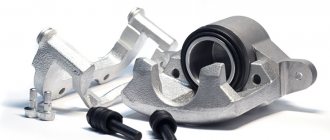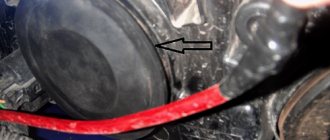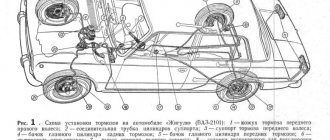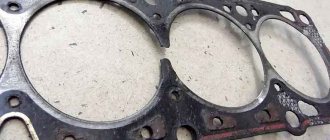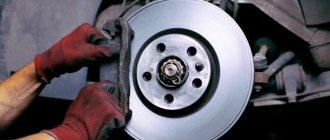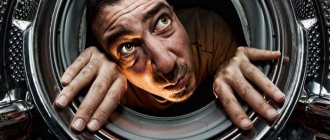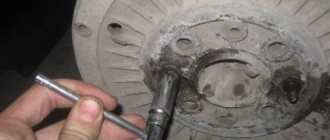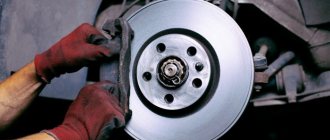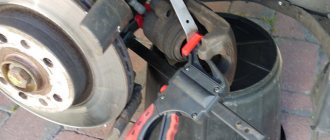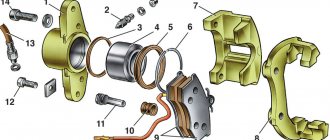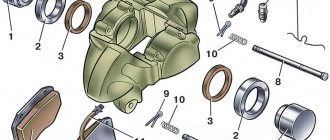Front caliper jammed
If the front brake caliper is stuck, this is often due to an aggressive driving style. This can be explained by the design difference of modern cars, where the brakes are applied faster at the front. Therefore, the burden here is incredible. Many cars are equipped with a pressure regulator or “sorcerer”. During heavy braking, it blocks fluid access, but only to the rear axle. The front axle continues to work and heat up.
However, if the rear caliper is equipped with a handbrake system, which is provided on some modifications, the likelihood of breakdowns and the rate of wear also increases.
Pad or disc wear
Usually the pads wear out first. After approximately 40 thousand km, their characteristics deteriorate. They react to heating and getting wet by losing their adhesion properties. The friction lining becomes thinner and “hardens”, causing braking to become “sluggish” and the driver has to press the pedal harder, which in turn causes even more wear.
After the third change of pads, with a mileage of about 120 thousand km, the brake discs on the front axle also have to be changed. Drums on the rear wheels, with proper maintenance, can last 200 thousand km.
Replacing brake discs does not always go smoothly, as they often stick to the hub due to developed corrosion processes. During heating, oxidation occurs faster.
To combat rust, you can use copper grease. It contains ultrafine copper, which makes it resistant to high temperatures. However, copper grease cannot be used on non-ferrous metals. A galvanic reaction appears and the oxidation process intensifies.
What to do if the caliper is stuck on the road
The first thing that is recommended is to give the elements half an hour to cool down. Then identify the problem wheel by conducting an effective test. You need to drive 20-30 meters, stop and touch all four disks with your finger through the provided holes. If the part is hot, it is this particular wheel that jams. It is removed, the car is first placed on a jack.
Cold water will help to quickly cool the elements, but you can water it on a surface that has already partially cooled. Otherwise, the disk will simply blow apart due to strong temperature changes.
If the handbrake cable jams, the inner or outer braid is most likely damaged. It is possible that the return spring has weakened and needs to be replaced with a new one. Also, both return brackets often become dirty. In this case, they must be cleaned of rust and treated with VD-40.
But what to do if sometimes you don’t have time for all this. Then the only way remains is to hit the return bracket with a hammer so that the cable returns to its original position. You can drive further, but just don’t use the handbrake again until it is repaired.
If the piston itself is jammed, a hammer can also quickly solve the problem. You need to tap it carefully, through a wooden spacer, throughout the entire mechanism. If the pads do not wedge, try inserting a screwdriver between the pad and the disc. Finally, the surest, but most dangerous way is to squeeze the hose with a clamp. But you must drive extremely carefully, without brakes.
Guide faulty
The main problem if the brake does not work can be jamming and souring of the caliper guides.
Repairing this malfunction with your own hands will not be difficult. By the way, in this case there is no difference when disassembling both the front and rear calipers. To do this, you need to unscrew and pull out both guides. Clean them from dirt or poor-quality lubricant, remove and replace the torn boots with new ones, after filling them with special grease for calipers.
Then put them in place, insert and screw the guides back. Then you should try how freely the pressure bar moves along them. This can be seen visually in the attached video at the end of the article.
We should not forget about the housing of this brake element. If significant rust, dents, sagging or other mechanical damage is found on it, it should be replaced completely.
If the repair had to be done on a removed caliper, then after installing it in place, the brake system should be bled.
Consequences
When the bracket wedges, the block remains pressed. This causes the discs to become very hot and the shoes to burn. If the speed of movement is high, and the degree of constriction is maximum, then it’s red-hot. It is obvious that braking efficiency drops sharply, the linings and disc become washed out and lose their properties.
After several heating and cooling procedures, the disks are sure to become deformed. After pressing the pedal, you will feel a beating, and you will not be able to brake at all. You will have to replace the repair kit, but the troubles will not end there, because the cause of the malfunction is in the caliper. If the hub begins to heat up, then the bearing will crumble and the CV joint will be destroyed.
Prevention measures
Maintenance of the caliper must be carried out every time the pads are replaced, every two years. It is during this period that the lubricant loses its original properties. In Russian conditions, the timing of the inspection activity must be significantly reduced, and an inspection must be carried out in case of any extraneous sounds, the vehicle slipping and other signs of damage to the mechanism listed above.
The large loads to which the clamp is subjected require the use of special lubricants. Poor-quality compounds quickly harden and are destroyed by water or aggressive brake fluid. You need to use only high-temperature lubricant, with minimal dripping characteristics, moisture-resistant and not susceptible to chemicals. In addition, the correct lubricant must be compatible with plastic and rubber parts. A special type of lubricant is used for the fingers—the elements that guide the mechanism’s brackets.
Features of work
First, let's try to imagine the ideal operation of a caliper as part of a car's braking system.
In fact, this is a mandatory component of any car, be it:
- VAZ 2110;
- VAZ 2109;
- Lada Kalina;
- Chevrolet Lanos;
- Lada Priora;
- VAZ 2114;
- Chevrolet Niva;
- Lada Kalina;
- VAZ 2112;
- Daewoo Nexia;
- Volkswagen Polo Sedan;
- Skoda Octavia;
- Mercedes E class, etc.
Regardless of whether it is installed on a Niva or a BMW, the caliper must be in constant working order.
This is the direct task of the car owner himself. Or persons responsible for maintaining the machine and maintaining it in proper technical condition.
Before determining why it does not press out and what to do to prevent the car caliper from jamming, you need to understand the principle of its operation.
In optimal condition, when the brake assembly is working properly, the operating diagram looks like this:
- the driver presses the brake pedal;
- pressure is built up inside the braking system;
- this pressure is transmitted to the piston group of the auto calipers;
- the calipers, being under high pressure, bring the brake pads to the disc;
- the braking disc is attached to the car wheel;
- friction force arises;
- wheel rotation slows down;
- the car stops;
- or reduces the speed to the required values.
As you can see, in theory there is nothing complicated. But in fact, the caliper is rightly called an extremely complex element.
For the brakes to work effectively, it is important to ensure that the pad is parallel to the disc. Friction during active braking causes heat production
This heats up the pad, brake fluid and our caliper.
Friction during active braking causes heat production. This heats up the pad, brake fluid and our caliper.
Therefore, it is extremely necessary that the car caliper be made on the basis of a material that does not change its properties and characteristics during the process of strong heating. Plus, there are increased requirements for strength.
What to do if the caliper is stuck on the road - how to repair it yourself
Sometimes drivers encounter jamming of the brake unit. This is a situation on the road that is life-threatening. The caliper is one of the main elements of the brake system. It is present in any vehicle. Its main function is to press the brake pads against the disc when the driver presses the pedals. If the caliper is stuck on the road, you cannot stop the car using the brake. Every car enthusiast should familiarize himself with the signs of a breakdown and learn how to repair a part in an emergency.
How to turn an inoperative brake cylinder piston into a functional one?
1) At the very beginning of the operation, you will need to remove the wheel from the car.
Note! By the way, when you remove the wheel from the car, try to spin it while it is in the air; if it slows down, then some piston has actually become unusable!
2) After your wheel is removed, immediately remove the caliper from the car after it in order to get out the brake piston that is not working. (For information on how to remove the brake caliper on front-wheel drive cars, see the article: “Replacing the brake caliper on a VAZ 2109”, and for information on how to remove this caliper on a classic, see “this article”)
3) Now, when the caliper is removed from the car, you will need to find a vice, or a very strong compressor, in order to remove the piston from the brake cylinder, so if you have a vice, then go to it and clamp the piston itself and behind the caliper after Once you clamp the piston, pull it, and thereby the piston will be removed from its installation location.
Note! If you don’t have a vice, then pick up a compressor or something else where air can come out under pressure and thereby insert the hose from the compressor into the small hole in the caliper, namely where you connect the brake hose itself and then turn on the compressor and the piston will fly out of its installation location!
4) Next, take the removed piston in your hands and inspect it, if you find traces of rust on it as shown by the arrow in the photo below, then they will have to be removed using some kind of chemical or something else (A good example of cleaning the piston from rust, shown in one of the videos below), and after the rust has been removed, also inspect the brake caliper itself and finally reassemble all previously removed parts in the reverse order of removal and at the very end check their functionality.
Note! Still, a new piston is not too expensive in the store for our domestic cars, so if you have the opportunity, then it’s better to replace it with a new one and throw away the old one, because who knows after how long it will start to rot again, maybe it won’t even last for a week will last and thus you will again have to disassemble the entire brake system, and by the way, if the boot on it is torn, then you will definitely need to replace such a piston with a new one, since dirt has already got into the inner part and it is unlikely to be able to get it out, yes Moreover, there will still be lubricant there, so as they say, decide for yourself to repair the piston or replace it with a new one!
Additional video: If you want to know how to remove the piston from the brake cylinder on front-wheel drive cars using the VAZ 2109 as an example, then watch the video below, which explains all this in detail:
Source
Caliper jammed on the road: causes and symptoms
The caliper jams and fails due to overheating, dirt and moisture getting into it. There are also other provoking factors:
When a caliper jams, it is accompanied by a number of characteristic symptoms:
If the caliper jams on the road, the car may begin to brake on its own. This happens because the brake pads are in constant contact with the discs. As a result, the car will constantly brake, even when the driver does not touch the brake pedal. The pads will begin to deteriorate faster.
If even one of these phenomena is detected, it is important to take immediate measures - diagnose the brake system and eliminate the identified problems.
How to extend the life of car door seals
It is the creaking that indicates that the element is seriously worn out. In the near future, the unit must be replaced without fail, which the car literally and figuratively screams about. It is extremely difficult not to hear such a creak. But for some reason, thousands of motorists still stubbornly ignore it. As a result, they pay a rather high price. Sometimes even to the point of road accidents resulting from brake failure while driving. To prevent this, you need to understand the issue and understand the essence of what is happening.
The first step is to look at the possible causes. In fact, there are several potential problems to look for. Some of them arise due to the fault of the motorist, others are caused by the natural process of wear and tear.
In any case, the appearance of a squeak as a symptom is a harbinger that at the most inopportune moment the caliper may simply jam.
If you know the reasons, you can prevent them and troubleshoot them by contacting a car service center or solving the problem yourself.
The reasons are:
- The brake pads were initially installed incorrectly. As a result, they are not strictly parallel to the response drives. Because of this, creaking often appears;
- The brake discs are seriously worn out. The reasons are natural wear and tear and aggressive use of the car;
- There is no lubrication in the unit. Initially there was little of it, or it was used up;
- The lubricant was selected incorrectly. Many people skimp on lubricant intended for calipers, hence the consequences.
The most undesirable and dangerous situation is rightly considered when the piston does not return and the unit begins to jam during operation.
Imagine that you are driving a car, press the brake, and then accelerate again. But at the same time, the calipers do not release the front brakes. Additional resistance arises, the car tries to move, but cannot. The result is uncontrolled braking, extremely intense wear and serious overheating of the entire system.
How to carry out independent repairs if the caliper is stuck on the road
If the driver notices signs indicating that the brake mechanism is jammed, the following is urgently required:
Of course, there is no 100% guarantee of the effectiveness of this method, but when there is absolutely no time, like other available means, they resort to it.
It is best to carry out self-diagnosis. The algorithm is as follows:
Next, carry out the following actions:
When the driver does not have the skills to carry out emergency repairs, it is better to call a tow truck to take the car to professional mechanics.
AutoXS.ru - Auto Encyclopedia
Obviously, the braking system is one of the most important in a car.
It plays a key role in ensuring the safety of the driver, passengers and other road users. The car will not be able to stop if the brake calipers do not work. In order to determine whether there is a risk of a brake caliper seizing, it is necessary to know the characteristic symptoms of this problem, as well as the reasons for its occurrence. This will allow you to troubleshoot the problem.
Front caliper jammed: reasons
When the driver is used to driving at high speed, a little carelessly, then the front caliper often jams. This type of breakdown is more common in modern vehicles, where this mechanism operates faster in the front part. As a result, a colossal load falls on the caliper.
Most cars have a pressure regulator, which is popularly called a “sorcerer”. If you brake sharply, fluid access to the rear of the car is blocked. The front one continues to function and heat up.
Rear brake jammed: reasons
Typically, the structure of the rear caliper is complicated by the parking brake. The mechanism includes a number of elements:
When damage occurs in one of them, it affects the operation of the clamping device.
Mechanics quickly identify problems caused by problems with the handbrake. The main symptom is poor performance of the brake mechanism when trying to press on the pedals. There are also indirect manifestations: uneven wear of the linings, creaking, braking of the rear axle.
The design of this brake element
There are two types of disc calipers - front and rear, their design and repair method are slightly different, but their main elements are the same:
- The housing in which the piston (cylinder) is mounted.
- Bypass valve.
- Sealing ring.
- Piston (cylinder).
- Cylinder boot.
- Retaining ring.
- Frame.
- Pressure bar.
- Pads.
- Guide boot.
- Guides.
- 14. Fastening bolt.
- Brake hose.
Preventive actions
To avoid such an unforeseen situation when the caliper jams on the road, you need to take a number of preventive measures:
With timely care and careful operation of the car, the risk of the caliper getting stuck on the road is minimal. If such a nuisance happens on the road, you need to react quickly and clearly. Remember, if the caliper is jammed, this is fraught with an accident if you cannot cope with the vehicle.
Has your caliper jammed on the road? How did you deal with such a situation? Share your experience with other car enthusiasts.
What to do if the caliper sticks? Answer in video:
To give the calipers an aesthetic appearance, they can be painted. How to do this correctly - read the feature article.
Source
